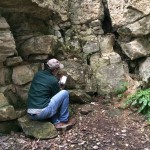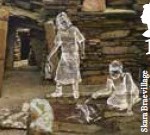Bournemouth University’s archaeologists have released a short video on one of their projects in which they have been working closely with partners at the famous Roman sites of The Roman Baths and Fishbourne Roman Palace. The project has been using new methods to examine the main materials used by the Romans in their buildings.
Project Director, Professor Mark Brisbane, said “When the Romans arrived in Britain in the first century AD they brought with them a new form of architecture that used carefully cut, squared stone blocks and materials made of fired clay such as bricks and tiles. This would have been a completely new form of construction to most of the local inhabitants whose main building materials were wood, thatch and daub.”
In order to better understand these ‘new’ materials of the Roman World, the Building Roman Britain project investigated their composition and production through an innovative programme of archaeological science. To do this, BU’s Department of Archaeology, Anthropology & Forensic Science worked in a knowledge exchange partnership with two well-known heritage organisations, Fishbourne Roman Palace Museum near Chichester and The Roman Baths in the City of Bath.
The project aimed to characterise stone and ceramic building materials (the bricks, tiles, etc.) by using a relatively new type of instrument known as portable X-ray Florescence (or pXRF for short). This allows us to chemically ‘fingerprint’ archaeological examples of these materials, so that we can learn more about where the stone was quarried and where the ceramic building material was produced.
Mark Brisbane added, “Central to the project was a need to communicate the process of scientific discovery to the general public. To do this we decided to produce a short video to communicate to a wide audience the project’s novel scientific approach to understanding the organisation of early Roman Britain’s building industries. We are particularly grateful to our partners in Bath and Fishbourne for their assistance in the project and to IMMIX Media Ltd who brought their creative know-how to the video and its production.”
As well as discussing the project’s results and their implications, the video includes an outline of the development of the project, the manner in which questions were structured to examine the potential and limitations of the use of the handheld pXRF, and the way in which the approach was applied within the museums and in the field. Some preliminary results are also discussed as well as where the project goes next.
The work was largely funded by HEIF (Higher Education Innovation Fund), part of HEFCE (the Higher Education Funding Council for England) and will be the subject of on-going collaborations between the university and our partner museums.
The work has subsequently helped underpin a successful bid by The Roman Baths to the Heritage Lottery Fund for a major new learning centre known as the Archway Project: https://www.romanbaths.co.uk/archway-project
For further information on the Building Roman Britain Research Project see: https://research.bournemouth.ac.uk/project/building-roman-britain/
For further information on Fishbourne Roman Palace see: https://sussexpast.co.uk/properties-to-discover/fishbourne-roman-palace
 Building Roman Britain: Project update
Building Roman Britain: Project update Ancient Britain through the post
Ancient Britain through the post










 Read and sign up to BU’s Policy Influence Digest
Read and sign up to BU’s Policy Influence Digest Upcoming opportunities for PGRs – collaborate externally
Upcoming opportunities for PGRs – collaborate externally BU involved in new MRF dissemination grant
BU involved in new MRF dissemination grant New COVID-19 publication
New COVID-19 publication MSCA Postdoctoral Fellowships 2024
MSCA Postdoctoral Fellowships 2024 Horizon Europe News – December 2023
Horizon Europe News – December 2023